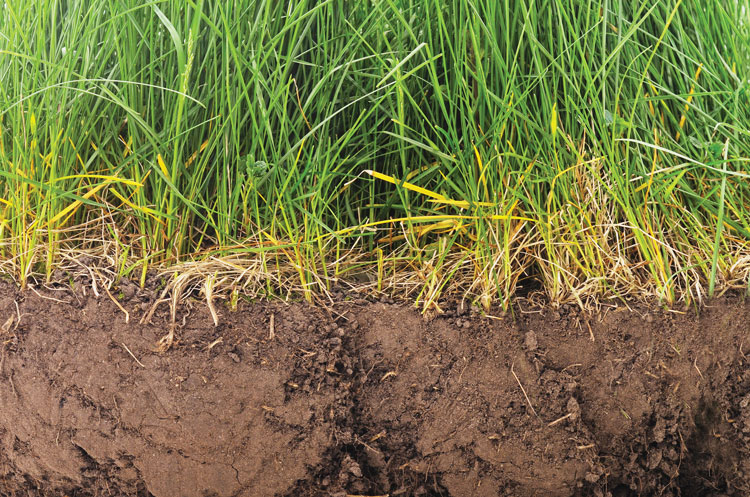
Carbon is fundamental to all life. It forms the backbone structure of carbohydrates (composed of carbon, hydrogen, and oxygen), which are the initial products from the miraculous process of photosynthesis. Energy from the sun is captured within chloroplasts of green plants using water taken up from the soil and carbon dioxide from the atmosphere. This starts the carbon cycle with the formation of sugars. These sugars or simple carbohydrates are transformed in plants to various complex carbohydrates, oils, proteins, and numerous other compounds specific to each plant group.
Animals and humans that consume these plants rely on the energy and phytochemicals embodied in these plant compounds for growth and daily maintenance. Soil microorganisms clean up the remaining carbon embodied in plant and animal residues to cycle carbon back to the atmosphere as carbon dioxide. Of course, there are many variations and complexities in the carbon cycle along the way, but the basic pathway is a rather straightforward and simple process. Carbon is the common currency along all stages of this cycle.
What is soil carbon?
Soil carbon in the eastern U.S. is primarily composed of organic carbon, which is carbon that was once living in plants and animals and has since been transformed by soil microorganisms feeding on these primary sources to form decomposition by-products of soil organic matter. Soil carbon in the western U.S. can also be composed of inorganic carbon from carbonates that precipitate with soil cations like calcium and magnesium.
Soil organic matter is composed mostly of carbon. In fact, carbon makes up 58% of soil organic matter while nitrogen makes up about 5% of soil organic matter. These two elements are often measured to determine the percentage of soil organic matter. The hundreds of billions of individual bacteria and fungi in a teaspoon of soil are composed of carbon.
The living component of soil may only compose 1% to 5% of total soil carbon. The large nonliving component of soil contains most soil organic carbon. Nonliving components of soil carbon can be in small organic matter pieces called particulate organic matter, in dissolved organic matter that makes standing water turn the color of tea, in humic matter that is highly stable and doesn’t break down easily, and in various inert organic components such as charcoal following burning of plant biomass.
Soil carbon is important to farmers, and it should be important to the public, because it is a vital determinant of ecosystem properties and an essential mediator of ecosystem processes and functions. This means that this relatively small component of soil provides many of the features of healthy soil needed to make it an excellent growing medium for forage crops and pastures, as well as to protect the environment and provide ecosystem stability. The mass of soil organic matter may compose from 1% to 10% of total soil weight, but this depends highly on climatic conditions, soil texture, landscape setting, and land management.
Many positive attributes
Carbon gives soil a dark color to absorb heat. Soil carbon has low solubility, ensuring that organic matter inputs are retained and not rapidly leached from the soil profile. Soil with high carbon content acts like a sponge to retain more water for plant growth, and it stabilizes soil structure to provide pore space for microorganisms and various soil critters.
Soil with a high carbon content enhances the cation exchange capacity that aids in the retention of cations like calcium, magnesium, potassium, ammonium, iron, and aluminum. Soil carbon buffers against pH swings to keep acidity in a more acceptable range for plants. Soil organic matter complexes metals to enhance dissolution of minerals, enhances availability of phosphorus, helps inhibit the loss of micronutrients, and reduces toxicity of heavy metals. Soil organic matter alters biodegradability, activity, and persistence of pesticides.
Soil carbon in organic matter offers a reservoir of metabolic energy to drive biological processes. Soil organic matter is a source of organic nutrients that are slowly released to plants via microbial activity. Soil carbon can enhance and inhibit enzymes that transform plant-available nutrients. High soil carbon content provides ecosystem resilience, enhancing the ability to recover from various disturbances, such as drought, flooding, tillage, and fire.
Forages play a role
It is increasingly recognized that improved forage and grazing land management can significantly benefit the carbon status of a soil, thereby promoting greater soil health features and ecosystem resilience. Climate change threatens ecosystem process. Managing soils with greater soil carbon content will help farmers limit the negative consequences of climate change.
Better forage management can be viewed as an effective adaptation strategy to climate change, but it’s also an important mitigation strategy when deployed over large areas — carbon in the atmosphere is transferred to fixed carbon stored in soil organic matter. In the next issue of Hay & Forage Grower, I’ll describe in more detail how land management can affect soil organic matter content.
This article appeared in the August/September 2023 issue of Hay & Forage Grower on pages 10-11.
Not a subscriber? Click to get the print magazine.

